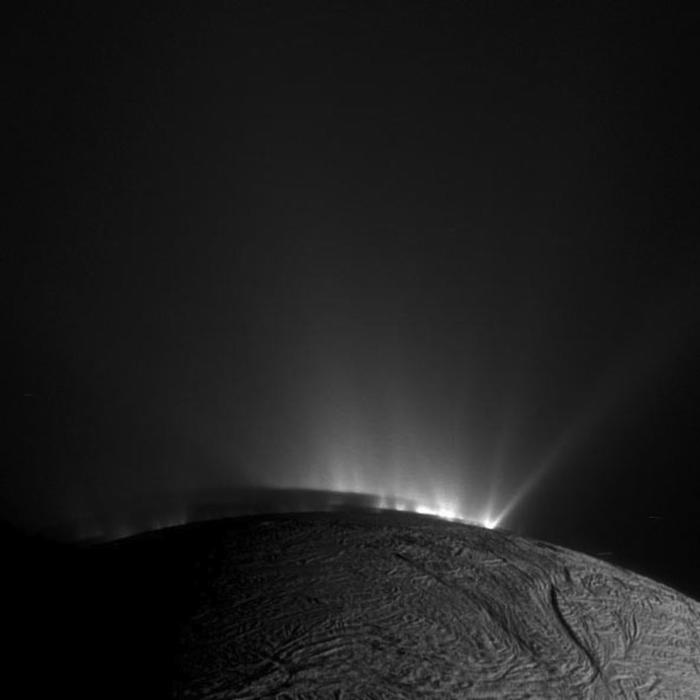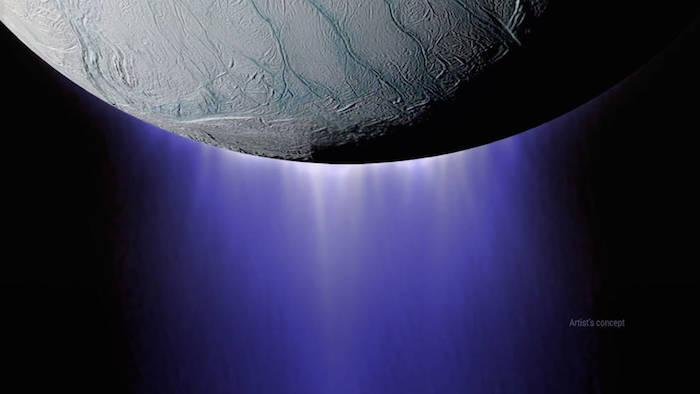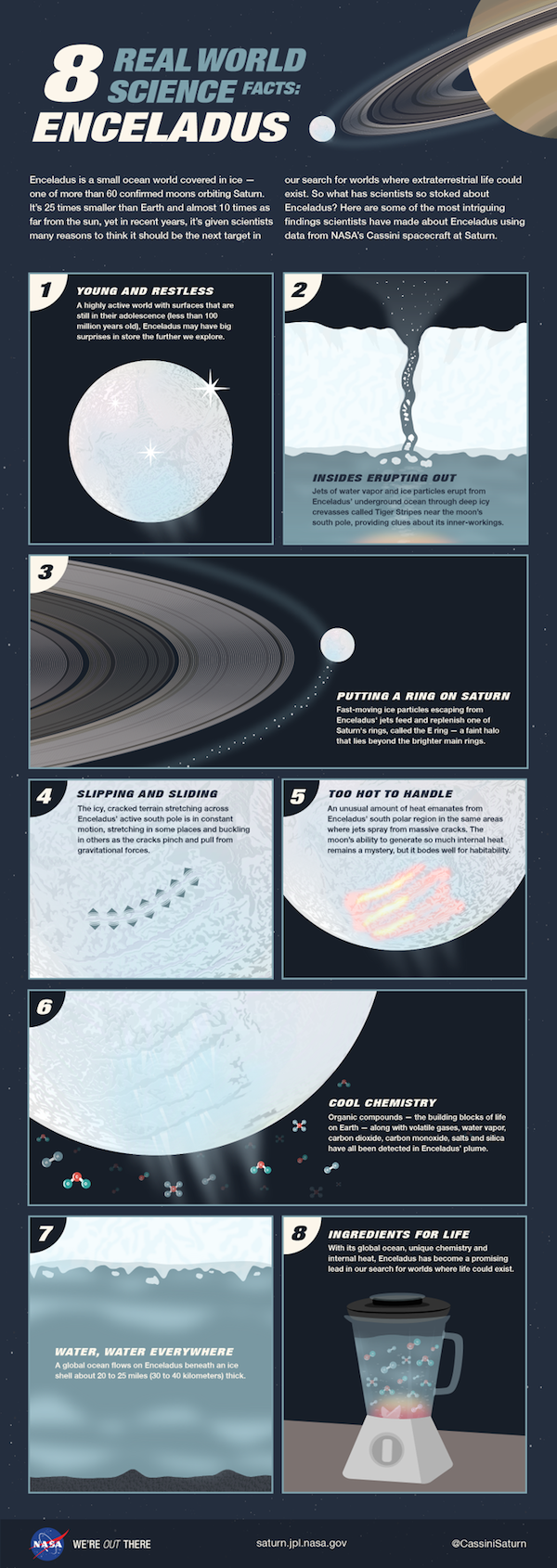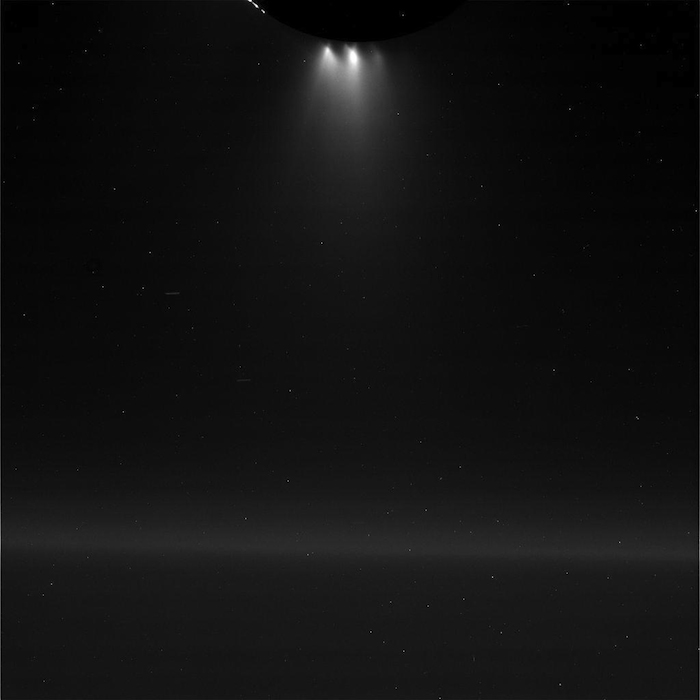.
28.10.2015

Summer may be long since over, but NASA’s Cassini spacecraft wants to make one more run through the sprinklers. The probe will be plunging through the plumes of salty water spraying from the southern pole of Saturn’s icy moon Enceladus on Wednesday, in an attempt to learn more about the ocean within.
Cassini will come within about 30 miles of the surface, whizzing through the plumes at a whopping 19,000 miles per hour – giving it just a few tens of seconds to sample the plume of water ice, vapor, organic compounds and other chemicals being released into space.
“It is going to be over in an instant,” Earl Maize, Cassini’s project manager at NASA’s Jet Propulsion Laboratory, said at a news briefing Monday.
NASA’s Cassini mission arrived at the Saturnian system with the goal of studying the ringed gas giant and its diverse panoply of lunar satellites. Cassini can’t land on Enceladus to directly sample its content. That’s why the geysers erupting from slits known as ‘tiger stripes’ are so valuable – they bring the moon’s contents to the spacecraft.
This isn’t the spacecraft’s final flyby of Enceladus, but it is the deepest dive through the plume, giving researchers an unprecedented taste of its contents and more clues about how friendly this little moon would be to microbial life.



As Cassini found evidence of a global ocean underneath the moon’s icy crust, those tiger stripes shed light on that liquid reservoir’s contents. A recent paper discovered signs of hydrothermal activity beneath the icy crust – which could mean the presence of the kinds of underwater vents that on Earth are host to deep sea microbial life.
For a study published today in the journal Nature Communications, scientists took what is already known about the geysers’ contents, particularly the silica nanoparticles in the plumes, and then performed laboratory experiments to simulate the conditions needed to create them. They found that the icy moon’s core must be similar in composition to meteorites known as carbonaceous chondrites – which could mean it formed very early in the solar system's history. Their results also showed that the conditions needed to form silica are high enough to support a habitable environment.
“Under the required conditions, hydrogen production would proceed efficiently, which could provide chemical energy for chemoautotrophic life,” the study authors wrote.
Exoplanet hunters searching for "Earth-like" worlds around distant stars have long wondered whether life exists in other parts of the universe, and how common it may be.
“If it arose twice in one solar system, the implications for how probable and how frequent it arises in the universe as a whole are profound,” Curt Niebur, Cassini’s program scientist at NASA in Washington, D.C., said at the news briefing.
Quelle: Los Angeles Times
-
Update: 29.10.2015
.
Deepest-Ever Dive Through Enceladus Plume Completed

NASA's Cassini spacecraft completed its deepest-ever dive through the icy plume of Enceladus on Oct. 28, 2015.
Credits: NASA/JPL-Caltech
NASA's Cassini spacecraft successfully completed its close flyby of Saturn's moon Enceladus today, passing 30 miles (49 kilometers) above the moon's south polar region at approximately 8:22 a.m. PDT (11:22 a.m. EDT). Mission controllers established two-way communication with the spacecraft this afternoon and expect it to begin transmitting data from the encounter this evening. Images are anticipated in the next 24 to 48 hours.
The Cassini-Huygens mission is a cooperative project of NASA, ESA (European Space Agency) and the Italian Space Agency. NASA's Jet Propulsion Laboratory in Pasadena, California, manages the mission for the agency's Science Mission Directorate in Washington. JPL is a division of the California Institute of Technology in Pasadena. The Cassini imaging operations center is based at the Space Science Institute in Boulder, Colorado.
Quelle: NASA
-
Update: 30.10.2015
.
Warten auf die ersten Fotos von Durchflug von Cassini

...
Update: 16.45 MEZ
.
Saturn's Geyser Moon Shines in Close Flyby Views

This unprocessed view of Saturn's moon Enceladus was acquired by NASA's Cassini spacecraft during a close flyby of the icy moon on Oct. 28, 2015. Image credit: NASA/JPL-Caltech/Space Science Institute
NASA's Cassini spacecraft has begun transmitting its latest images of Saturn's icy, geologically active moon Enceladus, acquired during the dramatic Oct. 28 flyby in which the probe passed about 30 miles (49 kilometers) above the moon's south polar region. The spacecraft will continue transmitting its data from the encounter for the next several days.
"Cassini's stunning images are providing us a quick look at Enceladus from this ultra-close flyby, but some of the most exciting science is yet to come," said Linda Spilker, the mission's project scientist at NASA's Jet Propulsion Laboratory in Pasadena, California.
Researchers will soon begin studying data from Cassini's gas analyzer and dust detector instruments, which directly sampled the moon's plume of gas and dust-sized icy particles during the flyby. Those analyses are likely to take several weeks, but should provide important insights about the composition of the global ocean beneath Enceladus' surface and any hydrothermal activity occurring on the ocean floor. The potential for such activity in this small ocean world has made Enceladus a prime target for future exploration in search of habitable environments in the solar system beyond Earth.
Quelle: NASA
4327 Views
